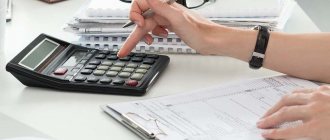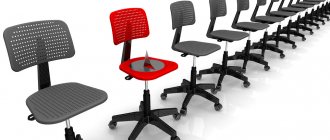Furniture: shock-absorbing group
Office furniture, as a rule, meets the requirements of current regulatory documents dictating the conditions for accepting property objects into the company's fixed assets.
Thus, in accordance with clause 4 of PBU 6/01, fixed assets (FPE) include assets: Office furniture fully falls under the listed conditions, and if it exceeds the value limit for recognition of an asset as part of material assets (more than 40 thousand rubles for unit), then, undoubtedly, is subject to accounting as an object of fixed assets. Note that in tax accounting, fixed assets are considered to be property worth more than 100 thousand rubles.
Depreciation period for office furniture
To correctly include an asset in, it is necessary to study the norms of the Russian Government Decree No. 1 of 01/01/02.
But the updated version of this legal document no longer contains the required name in the Classifier, so how then can the useful life of office furniture be determined?
For the answer, let's turn to Art. 258 of the Tax Code, which states that SPI is established by taxpayers independently based on the requirements and norms of Art. 258. And in paragraph 6 of Art. 258 it is determined that for objects not named in the Classification, the period is set based on the recommendations of manufacturers or technical specifications (specifications).
This means that the depreciation period for office furniture is determined by the company, based on the specific characteristics of the purchased property - durability, reliability, etc. Note! Before the entry into force of the new OKOF codes (SNS-2008), put into effect by Order of Rosstandart of Russia No. 2020-st dated
Production equipment is
The usual fire extinguishers that come to mind immediately are those found in every office: in the hallway or on the stairs. This category also includes special shields equipped with special fire extinguishing devices and sand boxes.
In addition to SPI, it is also necessary to evaluate the cost criterion for classifying it as fixed assets or low value. The limit is set by the company's accounting policy, but the legislator also controls this parameter. For tax authorities, it is important what you immediately include in the costs of the period, and what stretches out for a period of more than 1 year.
How to determine the useful life of office furniture and calculate depreciation - examples
– for accounting (set by the enterprise independently within the specified amount, fixed in the accounting policy); 100,000 rub.
– for tax accounting, all objects cheaper than the specified amount are not considered fixed assets, are not depreciated and are immediately written off. In general, office furniture - tables, chairs, cabinets, cabinets and other items fit the conditions for classification as OS objects. However, the required limit is not always met; often these items turn out to be cheap enough to be classified as fixed assets.
If all conditions, including the cost limit, are met, then the useful life of this property should be established in accounting and tax accounting. The depreciation group is determined without fail for depreciable property for the purpose of calculating income tax.
The Tax Code of the Russian Federation clearly requires taking the useful life from the permitted range for the depreciation group to which the fixed asset is assigned.
Furniture accounting at the enterprise: postings
The company must exercise control over the furniture that is on its balance sheet. All activities carried out for this purpose must be carried out in accordance with the company's accounting policies. In addition, the accountant must be familiar with the provisions of PBU 5/01 and PBU 6/01.
Accounting for office furniture is a responsible undertaking. To carry it out, a competent approach is required. Typically, updating and purchasing new furniture is carried out in small batches. Today a company can buy a cabinet, and a month later get new chairs.
How to properly record furniture in accounting
- D08 - K60 - at the time of registration of purchased expensive items;
- D19 – K60 - in the amount of VAT on purchased furniture;
- D60 - K50 or 51 - when making a payment to the supplier to repay the debt for the assets received.
Accounting for inexpensive furniture is carried out according to the standards of PBU 5/01. For organizations operating under a simplified taxation scheme, assets worth up to 100 thousand rubles with a long period of use are recognized as material costs. This eliminates the possibility of calculating depreciation for a specific object. Write-off is allowed after the furniture is put into use and the bill for the new property is paid.
Tax accounting for furniture purchases
The essence of the issue Choose a convenient method for you to control the safety of low-value property and write it down in the accounting policy for accounting purposes.
Fill out such a low-value property registration card for each object. And make entries in it on the basis of receipt and expenditure documents (receipt orders, invoices for the release of materials, etc.) on the day of the transaction. For example, when moving from one department of the organization to another or when leaving your company.
Thanks to such a low-value property accounting card, you will always know when and who received these objects, how long they were used in business and when they were written off.
In addition, if the tax authorities during the audit ask for documents confirming the movement of inexpensive property, you can provide them with this card.
Important
Account 08 also takes into account expenses associated with bringing pieces of furniture to a condition suitable for use (salaries of workers who carried out the assembly, insurance premiums from it, amounts paid to third parties for assembling furniture, and other similar expenses).
After completion of the formation of the initial value, as the fixed asset is put into operation, the amounts accumulated on account 08 are written off to the debit of account 01 “Fixed Assets”.
Taking into account the above, in the situation under consideration, pieces of furniture assembled (assembled) from individual component parts are taken into account as part of fixed assets and, in general, are recognized as subject to property tax.
Not all office equipment and inventory can be taken into account when writing off expenses. So, if there are no complaints about the purchased furniture, then the inclusion of some equipment in the documentation may raise questions among tax inspectors.
Property that was purchased Is it possible to write off expenses according to the simplified tax system and OSNO? Furniture items There will be no problems Equipment that makes office work easier It is possible to write off Air conditioners and heaters The company works according to the simplified tax system - there will be no problems The company works according to the simplified tax system - expenses will be canceled Kitchen appliances According to OSNO - accounting for expenses is allowed According to the simplified tax system - costs are not included in the list of permitted ones. Features of depreciation of office equipment and office furniture In a number of situations, depreciation may also be charged on office furniture and office equipment. If the object is part of the OS, the procedure is required.
How to properly record furniture in accounting
LOAN 012 - reflects the disposal of an object from the balance sheet (due to wear and tear, sale, etc.). This posting will mean that the property is no longer used in your business. And confirmation of this will be the write-off act. The form of such an act is approved by Resolution No. 71a.
However, it is too cumbersome and inconvenient for writing off low-value property. Therefore, it is better to develop your own sample act and approve it in the accounting policy for accounting purposes. An example of such a document is presented below.
Please note: Property should be assigned to an off-balance sheet account and written off from this account using single entries, without double entries.
The described procedure for accounting for “low value” on the balance sheet will allow you to establish control over objects from the moment they begin to be used until the time when they are written off due to wear and tear or disposal. Method two: get a “low value” accounting card.
We purchase office furniture (Chistyakova L.)
Accounting for inventories is carried out on off-balance sheet accounts. Property included in this category can be written off as expenses at once. The result of the write-off is the execution of the corresponding act.
If the cost of the purchased furniture exceeds the established amount and the items comply with the requirements of PBU 6/01, they can be classified as OS. Question No. 2.
Which depreciation group includes furniture purchased by the company for the office? According to the classification of fixed assets, furniture can be classified into group 4.
Accounting and taxation of furniture components
Standard entries for furniture accounting When a company receives furniture from a counterparty, accounting records are created for the recording of new assets and their payment:
- D08 - K60 - at the time of registration of purchased expensive items;
- D19 – K60 - in the amount of VAT on purchased furniture;
- D60 - K50 or 51 - when making a payment to the supplier to repay the debt for the assets received.
The accountant is limited to this set of postings if the furniture was not put into operation immediately after purchase.
To start using assets, they must be officially transferred in accounting to the fixed assets involved in daily activities (provided that the furniture set has already been assembled and installed).
This is done by transferring the value of the object from credit 08 to debit 01 of account. Accrued depreciation is collected on account 02.
Documents without which stationery and other office expenses cannot be written off
Registration of furniture movement in accounting transactions is regulated by the standards of PBU 6/01 and the Tax Code of the Russian Federation. Furniture sets should be classified as fixed assets, and cheaper elements of the interior furnishings of premises are allowed to be reflected as part of the inventory. The distribution of furniture among different types of assets is complicated by the discrepancy between approaches to assessing objects in tax and accounting.
Rules for organizing furniture accounting To understand how to capitalize furniture purchased or received free of charge, you need to know its exact cost. The need to create an inventory card for the asset and carry out monthly depreciation deductions depends on the value of this indicator.
Documentary evidence that an object is assigned to an off-balance sheet account will be a log of the presence of valuables on off-balance accounts - you will keep this log in relation to all objects recorded on account 012.
In it, indicate the name of the property, its inventory number, cost, date of commissioning, responsible person, date of removal from off-balance sheet accounting. Make the initial entry in the journal on the basis of a demand invoice or other document according to which the property is decommissioned.
Unified forms of the corresponding forms can be found in Resolution of the State Statistics Committee of Russia dated October 30, 1997 No. 71a (hereinafter referred to as Resolution No. 71a). Or you can develop your own “primary”. When the property becomes unusable or you decide to sell it, etc.
The main equipment can be considered furniture that:
- used to implement the tasks of the company’s core activities;
- will be used for a long time (more than a year);
- not planned to be put up for sale in the short to medium term;
- is able to bring profit to the organization and increase revenue;
- the valuation reaches the lower threshold established by law for recognition as a fixed asset.
If the full list of criteria is not met, the acquired objects must be taken into account as inventory. ATTENTION! To recognize furniture as a fixed asset, according to accounting rules, its value must be at least 40 thousand rubles; in tax accounting, the lower valuation limit is approved at 100 thousand rubles.
We believe that in a situation where a company acquires fixed assets not in a ready-to-use form, but in the form of separate parts (components) that require assembly, it is possible to initially reflect these assets as materials on account 10 (for example, subaccount 10-2 " Purchased semi-finished products and components, structures and parts” or another subaccount). When completing items of furniture from individual items (wardrobe, wardrobe, etc.), the cost of components is transferred from account 10 to account 08 in the context of individual fixed assets. It is advisable to consolidate this accounting procedure in the accounting policy of the organization.
The category includes expenses necessary to carry out business activities. Example 1. The Iskra company is on the simplified tax system and makes payments based on the income-expenses system. In January 2020, the organization decided to purchase a cabinet, the cost of which was 5,000 rubles.
Source: https://kodeks-alania.ru/nalogovyj-uchet-pokupka-mebeli/
What depreciation group does furniture belong to?
Office furniture of an organization generally satisfies the conditions for recognizing it as fixed assets (clause 4 of PBU 6/01, clause 1 of Article 257 of the Tax Code of the Russian Federation). And if it also exceeds the cost limit established by the organization in its Accounting Policy for accounting purposes (no more than 40,000 rubles per unit), then it is subject to accounting as part of fixed assets in account 01 “Fixed Assets” (clause 5 of PBU 6 /01, Order of the Ministry of Finance dated October 31, 2000 No. 94n). In tax accounting, furniture is recognized as an object of fixed assets if its initial cost exceeds 100,000 rubles per unit. Recognizing furniture as an object of fixed assets, it must be depreciated (clause 17 of PBU 6/01, clause 1 of Article 256 of the Tax Code of the Russian Federation). What is the depreciation group for office furniture? And what is the useful life of furniture to set in accounting? We'll talk about this in our consultation.
How to accept an OS object for accounting
All expenses for the acquisition, construction and production of fixed assets are recorded as a debit to account 08 “Investments in non-current assets”. As a result, a value equal to the initial cost is formed here. At the moment when the object is accepted for accounting as fixed assets, the accountant writes off this value as a debit to account 01 “Fixed Assets”.
There are no clear rules regarding exactly when an object should be transferred to fixed assets. Therefore, companies have the right to independently establish this point and record it in their accounting policies. Most often, a fixed asset is placed on the balance sheet on the date of commissioning, or on the date when the object is ready for operation (for example, after successful testing).
Assets whose value does not exceed 40,000 rubles can be reflected as part of inventories. This means that the company has the right to record such objects on account 10 “Materials”, and immediately write off the cost as current expenses. Similar rules apply in tax accounting, but there is a minimum value that allows the property to be classified as fixed assets higher, namely 100,000 rubles.
Special rules are established for real estate objects, the rights to which are subject to state registration. If the building has already been built and capital investments in it have been completed, the object must be recognized as a fixed asset, regardless of the fact of state registration. In a situation where the building has not yet been registered, it should be reflected in a special subaccount to account 01.
When accepting a fixed asset for accounting, the accountant draws up a report. You can use a unified form according to the OS-1 form (for buildings and structures - according to the OS-1a form, for groups of objects - according to the OS-1b form), or you can develop your own form.
Shock absorption group furniture
For property worth more than 100 thousand rubles, it is advisable to establish the same period in tax and accounting in order to avoid discrepancies. Sometimes the necessary means are not available either in the Classifier, but in OKOF. In this case, it can be determined using the manufacturer’s recommendations or technical documents. Other options are sending a request to the manufacturer or seeking clarification from the Ministry of Economic Development. At the final stage, you need to check the service life of the OS according to the documentation - enter information into the inventory card. When establishing different deadlines for tax and accounting, this must be reflected.
Often, when working in a company, the staff focuses on achieving the global goals set by management, not paying attention to the ambiance of the office, which is created by many objects and small things, including furniture. It is convenient and comfortable furniture that employees owe to their very long working capacity, which bears fruit. Let's talk about furniture that is used in official premises and find out how it is accounted for and depreciated.
The table is the main tool or materials
An asset is accepted by an organization for accounting as fixed assets if the following conditions are simultaneously met: and the object is intended for use in the production of products, when performing work or providing services, for the management needs of the organization or for provision by the organization for a fee for temporary possession and use or for temporary use; b the object is intended for use for a long time, that is, a period of more than 12 months or a normal operating cycle if it exceeds 12 months; the organization does not intend the subsequent resale of this object; g the object is capable of bringing economic benefits to the organization and income in the future. General expenses: salaries of administration, accountants, office rent, etc. The exception is the situation when such costs are not associated with the entire organization, but only with a given fixed asset, for example, a bonus awarded to an engineer for setting up new equipment. If in subsequent periods the same object is marked down, the amount of the markdown must be attributed to the reduction of additional capital and reflected in the debit of the account
Recognition of fixed assets as depreciable in accounting and tax accounting depends, among other things, on their cost. At the same time, this criterion may be lowered in the Accounting Policy for accounting purposes. Accordingly, when such property is used, its cost will be reflected as expenses associated with production and sales, or non-operating expenses. Used for salary indexation. Used to regulate wages.
| ATTENTION! The material was updated as of 05/01/2017. Read more here |
The material has been archived
PURCHASING OFFICE FURNITURE: WE WILL CONSIDER AND FIGURE IT CORRECTLY
“This is a chair—they sit on it”—words familiar from childhood. Furniture is needed everywhere: in offices, industrial premises, warehouses, and sales areas. In addition, high-quality office furniture is the calling card of any company. Therefore, organizations often change furniture and update the interior. However, when purchasing and posting furniture, an accountant should take into account some nuances that will be discussed in this material.
Criteria by which furniture is classified as fixed assets or individual items as part of working capital
The procedure for recording furniture in accounting depends on its functionality and cost.
Functionality as a criterion for classifying assets as fixed assets is defined for furniture (as, indeed, for all fixed assets) in clause 2 of the Instructions for accounting of fixed assets, approved by Resolution of the Ministry of Finance of the Republic of Belarus dated December 12, 2001 No. 118 (hereinafter referred to as Instruction No. 118) . Thus, the organization accepts assets that have a tangible form for accounting as fixed assets, subject to the simultaneous fulfillment of the following conditions:
- they are intended for use in the production of products, when performing work or providing services, for use in auxiliary, service industries and farms, for the management needs of the organization, or for provision by the organization for a fee for temporary possession and use or for temporary use;
- intended for use for a period exceeding 12 months;
— capable of bringing economic benefits (income) to the organization in the future;
— at the time of purchase, their resale is not intended.
| From the editors of "Business-Info" On January 1, 2013, Resolution of the Ministry of Finance of the Republic of Belarus dated April 30, 2012 No. 26 came into force, which repealed Resolution No. 118 and approved the new Instructions for accounting of fixed assets. |
As a cost criterion when classifying furniture as fixed assets, one should consider the value of the limit for classification as fixed assets established in the accounting policy of the organization. Thus, organizations may not classify them as fixed assets and take into account assets in circulation with a value within the limit established in the organization’s accounting policy, but not more than 30 basic units per unit (clause 4 of Instruction No. 118).
Thus, if furniture, in terms of its functionality and cost, meets the criteria for classification as fixed assets, it should be taken into account as part of non-current assets. But if any of the criteria are not met, furniture should be taken into account as part of the items in circulation.
Accounting for furniture as part of fixed assets
Documenting. The procedure for organizing the accounting of fixed assets and reflecting transactions with them on accounting accounts is established by the Instruction on reflecting business transactions with fixed assets in accounting, approved by Resolution of the Ministry of Finance of the Republic of Belarus dated December 20, 2001 No. 127.
| From the editors of "Business-Info" Since January 1, 2013, instead of Instruction No. 127, the Instruction on accounting of fixed assets, approved by Resolution of the Ministry of Finance of the Republic of Belarus dated April 30, 2012 No. 26, has been in force. |
Acceptance of fixed assets for accounting is carried out on the basis of an act on acceptance and transfer of fixed assets approved by the head of the organization. From May 20, 2011, an organization accepting fixed assets for accounting draws up an act of acceptance and transfer of fixed assets in the form given in Appendix 1 to Resolution of the Ministry of Finance of the Republic of Belarus dated April 22, 2011 No. 23.
To organize accounting and ensure control over the safety of furniture, each inventory item (unit of product), regardless of whether it is in operation or in stock, is assigned a separate inventory number. Inventory numbers are assigned by the organization's accounting department at the time the furniture is accepted for accounting.
If an object consisting of several parts (for example, a furniture set, a set of furniture) has a common useful life for the objects, the specified object may be listed under one inventory number.
Analytical object-by-object accounting of fixed assets is carried out by the organization’s accounting department on inventory cards for accounting for fixed assets in the form OS-6 “Inventory card for accounting for fixed assets.” An inventory card is opened for each inventory item. If an inventory item includes individual devices and accessories that form one whole with it, then its inventory card contains a list of individual parts.
For information
Starting from 2011, in the Republic of Belarus, in order to create favorable conditions for business activity in accordance with subclause 4.6 of clause 4 of the Directive of the President of the Republic of Belarus dated December 31, 2010 No. 4 “On the development of entrepreneurial initiative and stimulation of business activity in the Republic of Belarus”, it is envisaged to ensure significant reduction of the list of mandatory primary accounting documents and the number of details in them. Therefore, in 2011, regulatory legal acts were adopted to abolish mandatory requirements for the preparation of primary documents, as well as the forms of primary documents themselves, strict reporting forms, etc. Thus, from April 1, 2011, organizations were given the right to independently develop and approve forms of primary accounting documents containing the mandatory information established by subclause 1.4 of clause 1 of Decree of the President of the Republic of Belarus dated March 15, 2011 No. 114 “On some issues of application of primary accounting documents”, with the exception of the documents listed in the list of primary accounting documents approved by Resolution of the Council of Ministers of the Republic of Belarus dated March 24, 2011 No. 360.
| From the editors of "Business-Info" From July 25, 2014, Decree No. 114 on the basis of Decree of the President of the Republic of Belarus dated July 21, 2014 No. 361 became invalid. The requirements for primary accounting documents are determined by Article 10 of the Law of the Republic of Belarus dated July 12, 2013 No. 57-Z “On Accounting and Reporting.” |
As part of the ongoing liberalization, from May 20, 2011, Resolution of the Ministry of Finance of the Republic of Belarus dated December 8, 2003 No. 168 “On approval of standard forms of primary accounting documents for accounting of fixed assets and intangible assets and Instructions on the procedure for filling out forms of standard forms of primary accounting documents for accounting of fixed assets” became invalid. funds and intangible assets." However, many business entities do not strive to reinvent the wheel and continue to use forms of primary accounting documents that have become obsolete, but have become familiar. Therefore, we recommend using the inventory card of the OS-6 form, modifying it taking into account the specifics of the activities of a particular organization.
Furniture can be purchased as individual products or as sets or sets. According to GOST 20400-80 “Furniture production products. Terms and definitions “furniture is a set of products intended for furnishing premises and other areas of stay. According to their intended purpose, furniture is divided into household and public buildings. Household furniture includes the entire range of furniture for residential premises. Depending on the purpose of the apartment premises, household furniture is divided into furniture for the dining room, bedroom, living room, kitchen, hallway, bathroom, etc. In terms of completeness, furniture is produced individually, in sets and sets. Sets are sets of furniture that have a single architectural and artistic design and are intended for furnishing a dining room, bedroom, office, kitchen, etc. Sets differ from sets in the large number of products included in the set. By design, the following types of furniture are distinguished: cabinet, prefabricated, non-dismountable, built-in, transformable, universally prefabricated, and sectional. Sectional furniture is furniture assembled from sections interlocked in various combinations; it decorates the interior of the room and meets high aesthetic requirements.
| From the editors of "Business-Info" Since March 1, 2020, instead of GOST 20400-80, GOST 20400-2013 “Furniture production products” has been in force. Terms and definitions”, approved by Decree of the State Standard of the Republic of Belarus dated December 15, 2014 No. 54. |
Basically, organizations purchase or order the production of furniture sets for the entire office. In this case, the contract should include a clause requiring that the cost of each product included in the furniture set be indicated in the shipping documents. In addition, according to subclause 4.3.2 of section 4 of the Methodological recommendations for planning, accounting and calculating the cost of woodworking products (works, services), approved by the President of the Bellesbumprom concern on December 10, 1999, the manufacturer must draw up a planned cost estimate for each product included as part of furniture sets and sets.
This information is necessary for the organization for proper accounting and control, since furniture from one set can be installed in different departments and assigned to different financially responsible persons. In addition, in a furniture set, some products can be taken into account as part of fixed assets, and others - as part of items in circulation, depending on the price and value of the cost criterion enshrined in the accounting policy of the organization.
Let's explain what was said. In accordance with the national classifier of the Republic of Belarus “Fixed assets and intangible assets” (OKRB 020-2002), approved by Decree of the State Standard of the Republic of Belarus dated September 27, 2002 No. 48, an inventory object is a complete device with all its fittings and accessories, or a separate, structurally isolated an object intended to perform certain independent functions, or a separate complex of structurally articulated objects that constitute a single whole and jointly perform a certain job. A complex of structurally articulated objects is one or more objects of the same or different purposes, having common devices and accessories serving them, general control, mounted on the same foundation, as a result of which each object included in the complex can perform its functions only as part of the complex, and not on one's own.
From the above, the conclusion follows: if each element of a furniture set can perform an independent function, each element of furniture should be assigned a separate inventory number.
Accounting. Actual costs associated with the purchase, production, delivery, installation, installation of furniture are reflected in accounting as follows.
| Contents of operation | Debit | Credit |
| In the manufacture of furniture using economic methods | ||
| The amount of actual costs for manufacturing furniture on our own | , , , , , and etc. | |
| When purchasing furniture or having it manufactured by a third party | ||
| For the amount of actual costs associated with the purchase (manufacturing), delivery, installation, installation of furniture | 08 | , , |
| For VAT amounts indicated by suppliers in primary accounting and settlement documents | , subaccount “Value added tax on acquired fixed assets” | 60, 71, 76 |
| For the amount of actual costs for objects accepted for accounting as part of fixed assets | 08 | |
| From the editors of "Business-Info" Since January 1, 2012, a new standard chart of accounts has been in force, established by Resolution of the Ministry of Finance of the Republic of Belarus dated June 29, 2011 No. 50. |
Another aspect that should not be forgotten: if a loan (loan) was received to purchase furniture, then the interest on it accrued after putting the furniture into operation can be taken into account in 2 ways in accordance with the procedure established in the accounting policy of the organization (clause 17 Instructions No. 118):
1) as part of investments in non-current assets during the reporting year with their inclusion in the value of fixed assets at the end of the year (except for interest on overdue loans and borrowings):
— Dt 08 — Kt 66, 67 — during the year;
- Dt 01 - Kt 08 - at the end of the year;
2) as part of operating expenses: Dt 91 - Kt 66, 67.
Depreciation calculation. In accordance with the Instructions on the procedure for calculating depreciation of fixed assets and intangible assets, approved by the resolution of the Ministry of Economy of the Republic of Belarus, the Ministry of Finance of the Republic of Belarus and the Ministry of Construction and Architecture of the Republic of Belarus dated February 27, 2009 No. 37/18/6, depreciation is calculated based on the depreciable cost of furniture, the established useful life (or standard service life of furniture not involved in business activities) and the chosen method (method) for calculating depreciation.
If there is a discrepancy between the service life of the furniture established by the manufacturing organization in the technical documentation and the value of the standard service life specified in the Temporary Republican Classifier of Depreciable Fixed Assets ( Note 1
), for a period of 1 year or more, the depreciation policy commission has the right to determine the standard service life according to the service life specified in the technical documentation of the manufacturer. At the same time, the organization must ensure the safety of the specified technical documentation throughout the entire service life of the furniture.
The accrued amount of furniture depreciation is reflected in the accounting records as follows:
| Contents of operation | Debit | Credit |
| The amount of accrued depreciation of fixed assets | , , 26, and etc. |
Accounting for furniture as separate items
Documenting. In the case when furniture is received as separate items as part of funds in circulation, it is reflected in account 10 “Materials”. Documentation and accounting of furniture in this case is carried out taking into account the norms of the Instructions for accounting of inventories, approved by Resolution of the Ministry of Finance of the Republic of Belarus dated November 12, 2010 No. 133 (hereinafter referred to as Instruction No. 133).
Note!
When purchasing furniture worth up to 2 basic units, which does not meet the criteria for classifying assets as fixed assets (by value, if the organization has specified in its accounting policy a limit on the value of assets as part of funds in circulation, or under other conditions), it must be taken into account as individual items as part of funds in circulation.
The basis for acceptance and posting of furniture is accompanying documents (waybills, delivery notes, etc.). Acceptance and posting of furniture is documented with receipt orders. The release of furniture from an organization's warehouse to its divisions can be formalized by a limit card, a demand-invoice, a demand, an invoice ( note 2
).
Accounting. The actual costs of purchasing furniture include:
— cost of furniture at the purchase price;
— customs fees and duties; fees paid to the intermediary organization through which the furniture was purchased;
— costs of procuring and delivering furniture to the place of its use, including insurance costs;
- costs of bringing furniture to a state in which it is suitable for use for the purposes provided for by the organization;
— transportation, procurement and other costs directly related to the purchase of furniture.
They are not included in the cost of furniture, but are included in the expenses of the reporting period in which they were incurred:
- interest on loans, loans received for the purchase of furniture, as well as remuneration to banks for servicing these loans;
— remuneration to banks for opening and executing letters of credit for payments for purchased furniture;
— exchange rate differences on obligations in foreign currency to suppliers for purchased furniture;
— costs associated with the acquisition of foreign currency for settlements with suppliers or repayment of loans for purchased furniture;
- other costs not directly related to the purchase and delivery of furniture.
Actual costs associated with the acquisition, production, delivery, installation, installation of furniture in which it is suitable for use are reflected in accounting records as follows:
| Contents of operation | Debit | Credit |
| For the cost of purchased furniture | 10-9-1, subaccount “Individual items as part of funds in circulation in the warehouse” | 60, 76 and etc. |
| For VAT amounts indicated in primary accounting and settlement documents | 18 | 60, 76 and etc. |
| The commissioning of furniture is reflected | 10-9-2, subaccount “Individual items as part of funds in circulation in operation” | 10-9-1 |
Wear. The cost of furniture as part of funds in circulation is transferred to the accounts for recording production costs and sales costs in accordance with the procedure established in the accounting policy of the organization (clause 107 of Instruction No. 133).
The transfer of the cost of furniture to the organization’s expenses is reflected in accounting by the following entries:
| Contents of operation | Debit | Credit |
| For the amount of repayment of the cost of furniture included in funds in circulation | 20, 25, 26, 44 and etc. | 10-9, subaccount “Individual items as part of funds in circulation in operation” |
Note 1. We are talking about the Temporary Republican Classifier of depreciable fixed assets and their standard service life, approved by Resolution of the Ministry of Economy of the Republic of Belarus dated November 21, 2001 No. 186 (hereinafter referred to as the Temporary Classifier). The temporary classifier for furniture (code 70020) establishes a standard service life of 10 years.
| From the editors of "Business-Info" From January 1, 2012, by Decree of the Ministry of Economy of the Republic of Belarus dated September 30, 2011 No. 161, new standard service life of fixed assets was established. |
Note 2. As stated above, currently there are no legally approved forms of limit-fence cards, receipt orders and other forms of accounting documentation. Therefore, we recommend that you independently develop the necessary accounting forms, taking as a basis forms M-1, M-4, M-7, M-8, etc., approved by Decree of the USSR State Statistics Committee of December 28, 1989 No. 241.
September 23, 2011
Margarita Zgirovskaya, auditor
Office equipment and furniture what cost is included in 01 account
Accounting for office furniture is carried out in accordance with the Chart of Accounts for accounting of financial and economic activities of organizations. The accounting procedure is fixed in the company's accounting policy. Office furniture costing over RUB. In this case, accounting is carried out at the original cost, which is obtained by subtracting taxes from the actual cost. The receipt of furniture is reflected by the following transactions: D-t 08 K-t 60 office furniture is capitalized D-t 19 K-t 60 the amount of VAT is reflected D-t 60 K-t 51, 52, 55 suppliers' invoices are paid. The disposal of office furniture can be reflected in the following transactions: D-t 91 K-t 01 residual value D-t 02 K-t 01 depreciation D-t 10 K-t 99 capitalization of material assets upon liquidation of the object D-t 91 K-t 99 profit from disposal, sale, transfer, liquidation D-t 99 K-t 91 loss from disposal. With furniture costing less than RUB reflected in accounting. In this case, furniture is written off when it is transferred to the place of use: D-t K-t 10 furniture was transferred to structural units. The choice of accounting option must be reflected in the company's accounting policy. There it is also necessary to fix a limit on the cost of furniture, which is taken into account as inventory.
The type of property is not included in the document. According to the established rules, if an object is not on the list, its useful life is established based on the recommendations of the manufacturer, Art. To do this, you need to read the documentation accompanying the purchased item. Based on the statement, office equipment can be included in group 2. Documents required for accounting Furniture accounting is a relatively complex process.
Accounting and taxation of furniture components
When assigning part of the furniture to the inventory, it is necessary to approve a scheme for ensuring the safety of such assets. For this purpose, it is recommended to use an off-balance sheet account in accounting. This way, the enterprise will be able to attribute the cost of inexpensive items to expenses immediately, but will not forget about the existence of purchased and used furniture, which will be reflected in the accounting data until its cost is written off from the credit of the off-balance sheet account. As an additional control measure, furniture is assigned to financially responsible persons who monitor its safety.
Classification of fixed assets
- production Production fixed assets include objects that are used in the normal activities of the organization, i.e. in production, construction, trade, etc.;
- non-productive. Non-productive fixed assets include objects that are not used in the normal activities of the organization. These are housing and communal services, scientific, cultural, healthcare institutions, etc.
- active - fixed assets that directly affect the subject of labor and affect production;
- passive - fixed assets that provide conditions for the normal flow of the production process.
New procedure for depreciation of fixed assets from 2020 - 2020
The Professional Development Center of the Earth-SERVICE Group of Companies invites you to take part in a consultation seminar 11:00 – 17:00 (lunch break from 13:30 to 14:15) Kaluga, st. Academician Koroleva, 16 (Four Points by Sheraton Hotel) The purpose of the seminar is to analyze legal conflicts in three areas:
The main documents regulating the procedure for accounting for fixed assets in state (municipal) institutions in 2020 are: GHS “Conceptual Framework”; Letter of the Ministry of Finance of the Russian Federation dated November 30, 2017 No. 02-07-07/79257; Letter of the Ministry of Finance of the Russian Federation dated December 15, 2017 No. 02-07-07/84237 (hereinafter referred to as Letter No. 02-07-07/84237); What needs to be included in the accounting policy for 2020 in terms of accounting for fixed assets?
13 Jan 2020 lawurist7 48
Share this post
- Related Posts
- Can the Financial Director's Property Be Foreclosed?
- Programs for the purchase of housing for young families
- What payments are due at the birth of the first child in 2020 to a low-income single mother?
- Can Judicial Officers Seize Property If Withholding From Pension Occurs?
Accounting office sofa
Hello. As for accounting for such a sofa: Pieces of furniture (costing more than 40,000 rubles per unit) used by an organization in its own office for management needs are recognized as fixed assets that are used in activities aimed at generating income (clause 1 of Article 257 of the Tax Code of the Russian Federation ).
Furniture has OKOF codes 16 2929000, 16 3222000, 16 3311000, 16 3612000. Fixed assets with such OKOF codes belong to the fourth depreciation group (see Classification of fixed assets included in depreciation groups “Furniture for printing production; cable and wire communications enterprises; medical; children's, school and preschool institutions; trade, catering and consumer services; libraries, theatrical and entertainment enterprises and cultural institutions; administrative premises, stations, financial institutions and communications enterprises; other special furniture").
Classifier of fixed assets by depreciation groups 2019
The current Classification of fixed assets by depreciation groups also provides for the distribution of fixed assets into 10 groups. We present these groups with an indication of their corresponding useful life and examples of OS objects belonging to such groups.
This is interesting: Can Bailiffs Seize a Car If It’s Sold?
Similarly, depreciation group 4 of fixed assets according to the 2020 Classifier assumes that the useful life of fixed assets belonging to this group is over 5 years up to 7 years inclusive. Therefore, for example, for telephone fax machines, the SPI can be set in the range from 61 months to 84 months. And fixed assets with a useful life of 85 months are already classified as depreciation group 5 of fixed assets according to the Classifier. Accordingly, for example, for dry cargo vessels of mixed river-sea navigation, the SPI can be established from 85 months to 120 months inclusive.
What applies to fixed assets
- Initial cost - according to its original cost, everything that relates to fixed assets is taken into account in the financial statements. This cost represents the full amount of actual costs on the part of the organization for the acquisition, production, or construction of a specific fixed asset, not counting VAT, as well as other refundable taxes. The initial cost of funds that are contributed to the accounts of contributions to the authorized capital of organizations is their direct monetary value, which is agreed upon by the founders. If the funds are received completely free of charge, that is, at a gift, the initial value, as a rule, is recognized as their value on the market at the current moment in time. Accounting provides for changes in the initial cost during additions, additional equipment, reconstructions, modernizations, partial liquidations, as well as revaluations.
- Residual value - residual value means the difference between the original cost and the depreciation accrued as a result of use. Fixed assets are reflected in balance sheets according to their residual value.
- Replacement cost - it evaluates fixed assets in current conditions, taking into account modern prices and technology.
After familiarizing yourself with what relates to fixed assets, as well as analyzing their valuation, you should understand how the funds under discussion can enter the organization. There are several ways:
Depreciation calculation
The PS will correspond to the assessment approved by the founders.
- Purchase or self-production.
In this case, the PS will be equal to the sum of the acquisition (manufacturing) costs, including delivery, installation, etc. - Free receipt. In this option, the PS is determined as the current market value.
- Linear method. In this case, to determine the amount of depreciation for the year, you need to divide the original cost by the useful life.
There are four methods for calculating depreciation.
They can be divided into two groups:
- SPI – useful life in years.
- PS – initial cost,
- A = PS / SPI, Where:
This is the simplest method by which depreciation can be calculated.
An example is given below. Example 1 The company purchased a car, SPI - 8 years, PS - 800 thousand.
rub. Depreciation for each year will be A = 800 / 8 = 100 thousand.
Accounting and tax accounting for depreciation of buildings, premises, apartments - postings, calculation of deductions, examples
Therefore, even in the case where the property has been owned for more than 30 years, you still need to calculate deductions every month.
Methods for calculating depreciation charges:
- .
- – accelerated non-linear method, in which depreciation is calculated from the residual value and the acceleration factor.
- – the calculation is carried out at the original cost when summing up the number of years of service life.
- – the cost is written off in equal installments over the entire period of investment.
In the vast majority of cases, for buildings, non-residential and residential premises, and structures, the linear method of calculating depreciation is chosen.
Which depreciation group does a computer in the Russian Federation belong to in 2020?
According to the Instructions, the definition of useful life period means the period during which it is possible to use, during the work of the organization, an object of non-financial assets for the purposes for which it was purchased, formed or received.
According to the generally accepted classifier OK 013-94, which was approved by Decree of the State Standard of Russia of December 1994 No. 359, all devices and equipment, without exception, that are included in a personal computer belong to the category “Machinery and Equipment”:










